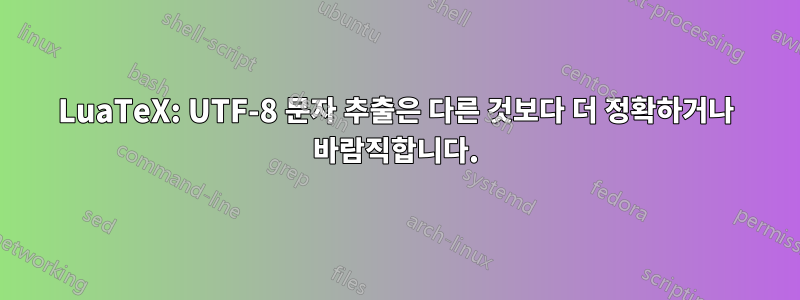
TeX 상자에서 UTF-8 문자열을 추출하는 방법을 실험하던 중 사용자의 게시물을 발견했습니다.미칼-h21여기:UTF-8 텍스트 추출. Glyph 데이터가 nodelist에 저장되는 방식을 살펴본 후 다른 접근 방식이 작동하는지 확인하기 위해 코드를 수정했습니다. 내 접근 방식에서는 구성된 복잡한 글리프/디스크의 구성 요소를 탐색하여 구성 문자를 추출합니다. 그의 접근 방식에서 그는 합자와 같은 복잡한 문자 모양을 일부 함수에 전달하여 분해하는 것 같습니다. 두 코드(예제의 테스트 문자열)에 의해 인쇄된 출력은 동일해 보입니다. 누군가 검토하고 두 가지 접근 방식이 모두 기능적으로 올바른지 제안해 주실 수 있습니까? (내 코드에 TeX 합자를 특별히 처리해야 한다는 것을 알고 있으므로 무시하십시오.) 그렇다면 어느 것이 성능에 더 좋을까요? (저는 unicode.utf8.char그와 같은 코드에 캐시할 수 있습니다. 성능에 대한 의견에서 불일치를 무시하십시오.)
다음은 터미널과 출력 파일 hello.txt에 기록된 출력 텍스트입니다. Příliš žluťoučký kůň úpěl ďábelské ódy difference diffierence.전체 코드는 다음과 같습니다.UTF-8 텍스트 추출, 우리 코드가 다른 점은 내가 그의 다음 함수( get_unicode)를 사용하지 않고 단지 unicode.utf8.char(glyphnodename.char)글리프 구성 요소에 적용된 것만 고수한다는 것입니다. 반면에 그는 get_unicode글리프 노드에서 더 깊은 레벨을 파고드는 대신 복잡한 글리프를 분해하기 위해 이 함수를 적용합니다. [내가 이해하는 한] 분해된 글리프).
local function get_unicode(xchar,font_id)
local current = {}
local uchar = identifiers[font_id].characters[xchar].tounicode
for i= 1, string.len(uchar), 4 do
local cchar = string.sub(uchar, i, i + 3)
print(xchar,uchar,cchar, font_id, i)
table.insert(current,char(tonumber(cchar,16)))
end
return current
end
\documentclass{article}
\usepackage[lmargin=0.5in,tmargin=0.5in,rmargin=0.5in,bmargin=0.5in]{geometry}
\usepackage{fontspec}
\usepackage{microtype}
\usepackage[english]{babel}
\usepackage{blindtext}
\begin{document}
\setbox0=\hbox{Příliš žluťoučký \textit{kůň} úpěl \hbox{ďábelské} ódy difference diffierence.}
\directlua{
local glyph_id = node.id("glyph")
local disc_id = node.id("disc")
local glue_id = node.id("glue")
local hlist_id = node.id("hlist")
local vlist_id = node.id("vlist")
local minglue = tex.sp("0.2em")
local function nodeText(n)
local t = {}
for x in node.traverse(n) do
% glyph node
if x.id == glyph_id then
if bit32.band(x.subtype,2) \csstring~=0 and unicode.utf8.char(x.char) \csstring~="“" and unicode.utf8.char(x.char) \csstring~="”" then %
for g in node.traverse_id(glyph_id,x.components) do
if bit32.band(g.subtype, 2) \csstring~=0 then
for gc in node.traverse_id(glyph_id,g.components) do
table.insert(t,unicode.utf8.char(gc.char))
end
else
table.insert(t,unicode.utf8.char(g.char))
end
end
else
table.insert(t,unicode.utf8.char(x.char))
end
% disc node
elseif x.id == disc_id then
for g in node.traverse_id(glyph_id,x.replace) do
if bit32.band(g.subtype, 2) \csstring~=0 then
for gc in node.traverse_id(glyph_id,g.components) do
table.insert(t,unicode.utf8.char(gc.char))
end
else
table.insert(t,unicode.utf8.char(g.char))
end
end
% glue node
elseif x.id == glue_id and node.getglue(x) > minglue then
table.insert(t," ")
elseif x.id == hlist_id or x.id == vlist_id then
table.insert(t,nodeText(x.head))
end
end
return table.concat(t)
end
local n = tex.getbox(0)
print(nodeText(n.head))
local f = io.open("hello.txt","w")
f:write(nodeText(n.head))
f:close()
}
\box0
\end{document}


